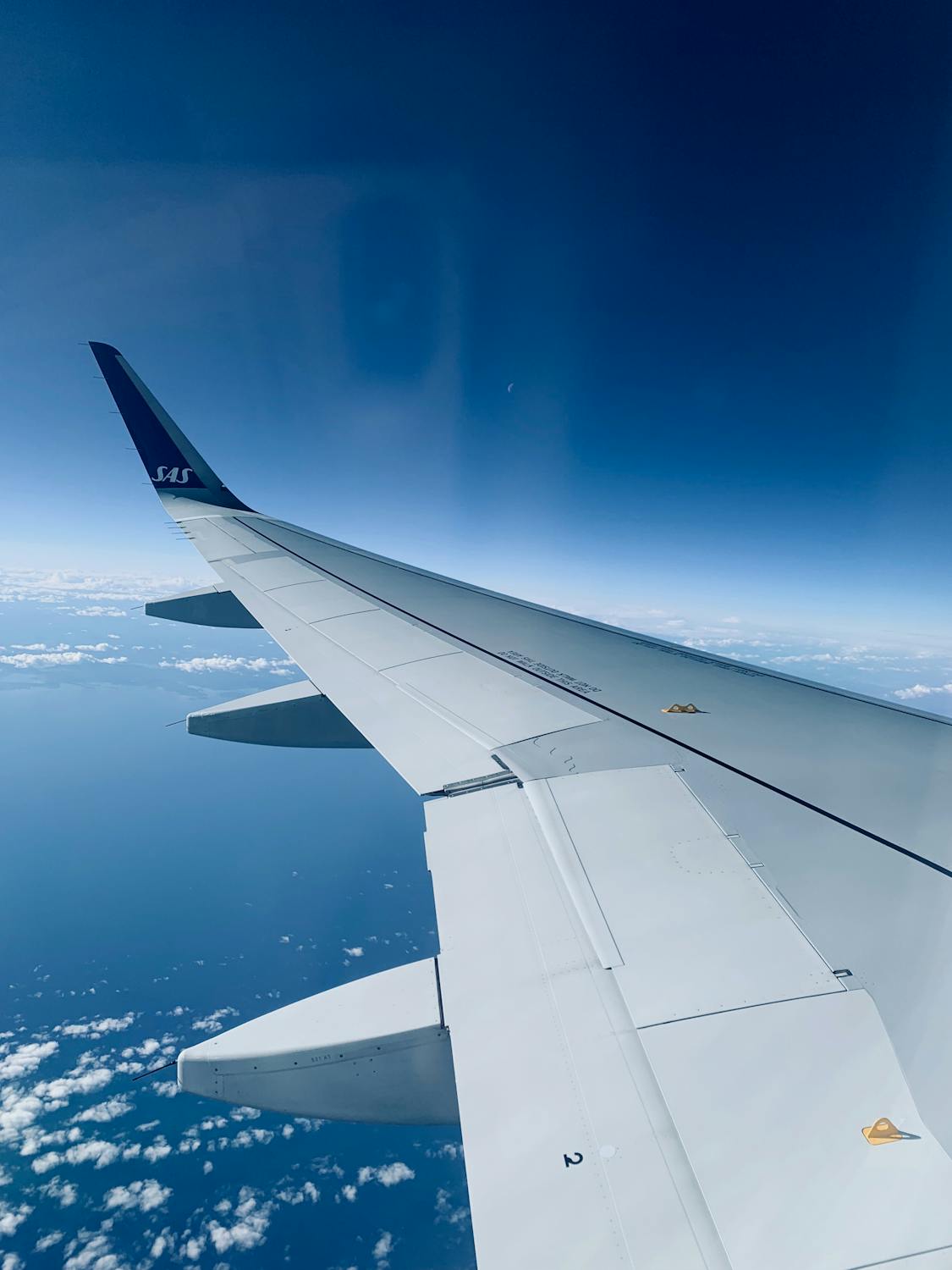“What Food Can Be Brought On A Plane?” is a common question for travelers. FOODS.EDU.VN clarifies the regulations and guidelines surrounding bringing food on airplanes, ensuring smooth travels with your favorite snacks and meals. This guide provides you with details on what foods are permissible, those that are restricted, and tips for packing them efficiently, along with information on airline food policies and food safety during travel, enhancing your travel experience with knowledge and assurance.
1. Understanding TSA Food Regulations for Air Travel
Navigating airport security can be stressful, especially when you’re unsure about what you can bring. The Transportation Security Administration (TSA) sets the rules, and they’re more flexible than you might think. Understanding these regulations ensures you can pack your favorite snacks without any hiccups. Let’s dive into what’s allowed and what isn’t.
1.1 General Rules on Solid vs. Liquid Foods
The TSA distinguishes between solid and liquid foods, which is crucial for packing your travel snacks. Solid foods are generally allowed in both carry-on and checked baggage. Liquids, however, are subject to the 3-1-1 rule.
Here’s a quick overview:
| Food Category | Carry-on Baggage | Checked Baggage |
|---|---|---|
| Solid Foods | Generally allowed | Allowed |
| Liquid Foods (over 3.4 oz/100 ml) | Restricted, unless medically necessary | Allowed |






This distinction is key to planning your in-flight meals and snacks.
1.2 The 3-1-1 Liquids Rule Explained
The 3-1-1 rule is a cornerstone of TSA’s liquid policy. It states that all liquids must be in containers of 3.4 ounces (100 milliliters) or less, placed in a single, quart-sized, clear plastic zip-top bag. Each passenger is limited to one such bag.
This rule applies to liquid foods like:
- Soups
- Sauces
- Jams and jellies
- Yogurt
- Dips
If you’re bringing these items, ensure they comply with the 3-1-1 rule or pack them in your checked baggage.
1.3 Exceptions for Medically Necessary Liquids and Foods
The TSA makes exceptions for medically necessary liquids, baby formula, breast milk, and food. These items are allowed in reasonable quantities exceeding 3.4 ounces and don’t need to fit in the quart-sized bag.
Remember to:
- Inform the TSA officer at the checkpoint.
- Remove these items from your carry-on bag for separate screening.
TSA officers may need to test these liquids for explosives or concealed prohibited items, but screening will never include placing anything into the liquid.
1.4 Food Items Generally Allowed in Carry-ons
Many food items are permitted in carry-on baggage, offering a variety of choices for your travels.
Commonly allowed foods include:
- Sandwiches
- Fruits and vegetables
- Crackers
- Chips
- Nuts
- Cookies and brownies
- Solid cheese
These items can be brought through security without much hassle, ensuring you have tasty options on your flight.
1.5 Foods Often Flagged by TSA
Certain foods are frequently flagged by TSA due to their liquid or spreadable nature. Being aware of these can save you time and prevent confiscation.
Foods that may cause issues include:
- Peanut butter
- Nutella
- Jams and jellies
- Creamy dips
- Liquid chocolate
If you want to bring these, make sure they meet the 3-1-1 rule or pack them in checked baggage.
2. Detailed List of Foods You Can and Cannot Bring on a Plane
To further clarify what you can bring on a plane, let’s break down specific food items into categories.
2.1 Snacks and Dry Goods
Snacks and dry goods are usually the easiest to bring. They are generally solid and pose no issue with TSA regulations.
- Allowed:
- Crackers
- Chips
- Pretzels
- Cookies
- Granola bars
- Nuts and seeds
- Dried fruits
- Cereal
Note: These are all permissible in both carry-on and checked baggage.
2.2 Fruits and Vegetables
Fresh produce can be a healthy and refreshing option for air travel.
- Allowed:
- Apples
- Bananas
- Oranges
- Grapes
- Carrots
- Celery
- Cucumbers
Note: Whole, uncut fruits and vegetables are fine. Cut fruits and vegetables should be well-packaged to prevent leaks.
2.3 Meats, Seafood, and Dairy
These items require more attention, especially if they are not shelf-stable.
- Allowed:
- Cooked meats (in solid form)
- Hard cheeses (like cheddar or parmesan)
- Shelf-stable canned or packaged seafood
- Restricted:
- Raw meats (subject to USDA regulations)
- Soft cheeses (if they are spreadable, follow the 3-1-1 rule)
- Seafood with strong odors (consider others on the plane)
Note: Check for specific restrictions based on your destination, especially for international travel.
2.4 Spreads, Sauces, and Dips
These are the trickiest because of their liquid or semi-liquid consistency.
- Allowed (under 3.4 oz/100 ml):
- Small containers of peanut butter
- Jams and jellies
- Honey
- Mustard
- Ketchup
- Salad dressings
- Restricted (over 3.4 oz/100 ml):
- Large containers of spreads, sauces, and dips
Note: If you can’t bring it in your carry-on, pack it in your checked baggage.
- Large containers of spreads, sauces, and dips
2.5 Baked Goods and Desserts
Most baked goods and desserts are easy to transport.
- Allowed:
- Cakes
- Brownies
- Muffins
- Pies (solid filling)
- Donuts
Note: Items with creamy or liquid fillings might be subject to the 3-1-1 rule.
2.6 Beverages
Bringing beverages requires careful consideration of the 3-1-1 rule.
- Allowed (under 3.4 oz/100 ml):
- Small bottles of juice
- Coffee or tea (if purchased after security)
- Restricted (over 3.4 oz/100 ml):
- Large bottles of water, juice, or other drinks (unless purchased after security)
Note: Empty bottles are allowed; you can fill them after passing through security.
- Large bottles of water, juice, or other drinks (unless purchased after security)
2.7 Specialty Foods
Certain specialty foods need extra attention due to their unique properties.
- Allowed:
- Baby food and formula (in reasonable quantities)
- Medically necessary foods and liquids
- Note:
- Inform the TSA officer about these items.
- Be prepared for additional screening.
3. Tips for Packing Food for Air Travel
Packing food properly can make your journey more enjoyable and hassle-free.
3.1 Choosing the Right Containers
Selecting the right containers is crucial for keeping your food fresh and preventing leaks.
- Reusable containers: Opt for BPA-free plastic or glass containers with tight-fitting lids.
- Ziplock bags: Ideal for snacks like nuts, crackers, and sandwiches.
- Insulated containers: Perfect for keeping food cold or hot for a few hours.
- Considerations:
- Ensure containers are easy to open and close.
- Choose containers that are lightweight to reduce baggage weight.
3.2 Keeping Food Cold or Hot
Maintaining the right temperature is essential for food safety and enjoyment.
- For cold foods:
- Use ice packs or gel packs to keep items chilled.
- Ensure ice packs are frozen solid when going through security.
- Consider insulated lunch bags or coolers.
- For hot foods:
- Use insulated containers designed to keep food warm.
- Heat food thoroughly before packing.
- Be mindful of potential odors that might affect fellow passengers.
- TSA Guidelines: Ice packs and gel packs are allowed but may be subject to additional screening if they are partially frozen or slushy.
3.3 Minimizing Odors and Messes
No one wants to be the passenger with the smelly or messy food.
- Odor control:
- Use airtight containers to prevent strong odors from escaping.
- Consider packing odor-absorbing materials like baking soda.
- Mess prevention:
- Wrap sandwiches and baked goods tightly.
- Use containers with secure lids to prevent spills.
- Pack utensils and napkins.
- Consider pre-cut portions to minimize mess.
3.4 Packing for Security Checks
Streamline the security process by packing your food strategically.
- Accessibility:
- Keep food items easily accessible in your carry-on.
- Place them in a separate bag or compartment for easy removal.
- Transparency:
- Use clear containers or bags to allow TSA officers to see the contents easily.
- Documentation:
- Have documentation for medically necessary foods.
- Be prepared to declare any liquids or gels.
- Cooperation: Be ready to answer questions and cooperate with TSA officers.
3.5 Labeling Food Items
Labeling your food can help you stay organized and inform TSA officers about the contents.
- Clear labels:
- Use labels to identify the contents of each container.
- Include dates if necessary, especially for perishable items.
- For medically necessary foods, clearly label them as such.
- Benefits:
- Helps TSA officers quickly identify the contents.
- Reduces the likelihood of delays.
- Keeps you organized during your trip.
4. Airline Food Policies and Options
Understanding airline food policies can help you decide whether to bring your own food or rely on what’s offered on board.
4.1 Overview of Major Airline Food Policies
Airline food policies vary widely, depending on the airline, route, and class of service.
- Full-service airlines:
- Often provide complimentary meals on long-haul international flights.
- May offer meals for purchase on domestic routes.
- Typically accommodate dietary restrictions with advance notice.
- Low-cost carriers:
- Usually do not offer complimentary meals.
- Provide a selection of snacks and beverages for purchase.
- May have limited options for dietary restrictions.
- Considerations:
- Check your airline’s website for specific food policies.
- Pre-order meals if possible, especially for dietary needs.
4.2 Ordering Special Meals
Many airlines offer special meals to cater to various dietary requirements.
- Types of special meals:
- Vegetarian
- Vegan
- Gluten-free
- Diabetic
- Low-sodium
- Religious (e.g., Kosher, Halal)
- How to order:
- Request special meals when booking your flight or at least 24-48 hours before departure.
- Confirm your meal request with the airline closer to your departure date.
- Important: Airlines cannot always guarantee special meal availability, so bringing backup options is wise.
4.3 Bringing Your Own Food vs. Buying Onboard
Deciding whether to bring your own food or buy it onboard depends on several factors.
- Advantages of bringing your own food:
- Cost savings
- Dietary control
- Personal preferences
- Healthier options
- Advantages of buying onboard:
- Convenience
- No need to carry extra items
- Variety of options (on some airlines)
- Considerations:
- Evaluate the cost and quality of onboard options.
- Assess your dietary needs and preferences.
- Consider the length of your flight and layovers.
4.4 Tips for Eating Healthy on a Plane
Maintaining a healthy diet while traveling is possible with some planning.
- Pack nutritious snacks:
- Fruits and vegetables
- Nuts and seeds
- Whole-grain crackers
- Protein bars
- Stay hydrated:
- Bring an empty water bottle and fill it after security.
- Avoid sugary drinks and excessive caffeine.
- Choose wisely when buying onboard:
- Opt for healthier options like salads, sandwiches, or fruit cups.
- Read nutrition labels to make informed choices.
4.5 Navigating Dietary Restrictions on Flights
Traveling with dietary restrictions requires careful planning and communication.
- Plan ahead:
- Research airline food policies.
- Order special meals in advance.
- Bring your own food as a backup.
- Communicate:
- Inform the airline of your dietary needs.
- Speak with the flight attendants about your restrictions.
- Be prepared:
- Carry a list of ingredients you can and cannot eat.
- Have snacks and meals readily available.
5. Food Safety During Air Travel
Ensuring the food you bring on a plane is safe to eat is essential for avoiding illness.
5.1 Best Practices for Keeping Food Fresh
Keeping your food fresh during travel involves proper storage and handling.
- Temperature control:
- Keep cold foods cold (below 40°F or 4°C).
- Keep hot foods hot (above 140°F or 60°C).
- Use insulated containers and ice packs.
- Packaging:
- Use airtight containers to prevent contamination.
- Wrap foods tightly to avoid exposure to air.
- Time limits:
- Consume perishable foods within a few hours.
- Avoid leaving food at room temperature for extended periods.
5.2 Avoiding Foodborne Illness
Preventing foodborne illness is crucial when traveling.
- Wash your hands:
- Wash your hands thoroughly before handling food.
- Use hand sanitizer if soap and water are not available.
- Safe food handling:
- Avoid cross-contamination by using separate utensils for different foods.
- Ensure food is cooked to safe internal temperatures.
- Storage:
- Store food properly to prevent bacterial growth.
- Dispose of any food that has been left at room temperature for too long.
5.3 Special Considerations for Baby Food and Formula
Traveling with infants requires extra attention to food safety.
- Preparation:
- Prepare baby food and formula according to manufacturer’s instructions.
- Use clean water and sterilized equipment.
- Storage:
- Store baby food and formula in a cool, dry place.
- Refrigerate opened containers promptly.
- Transportation:
- Use insulated containers to maintain temperature.
- Be prepared to show baby food and formula to TSA officers.
5.4 Handling Allergies and Food Sensitivities
Managing allergies and food sensitivities requires careful planning and communication.
- Inform airlines:
- Notify the airline of your allergies or sensitivities when booking your flight.
- Bring safe foods:
- Pack your own meals and snacks to avoid allergens.
- Read labels carefully to ensure foods are safe.
- Communicate with staff:
- Inform flight attendants of your allergies.
- Ask about ingredients in onboard meals.
- Emergency plan:
- Carry necessary medications, such as epinephrine auto-injectors.
- Know the symptoms of an allergic reaction.
5.5 International Travel Considerations
Traveling internationally requires additional awareness of food safety regulations.
- Customs regulations:
- Be aware of restrictions on bringing certain foods into other countries.
- Check the customs regulations of your destination country.
- Food safety standards:
- Be cautious about eating street food or food from unfamiliar sources.
- Ensure food is properly cooked and handled.
- Water safety:
- Drink bottled water or water that has been boiled.
- Avoid ice in drinks if you are unsure of its source.
6. Navigating International Food Regulations on Flights
International travel introduces a new layer of complexity when it comes to bringing food on a plane. Different countries have varying regulations, and it’s crucial to be aware of them to avoid any issues at customs.
6.1 Understanding Customs Regulations for Food
Customs regulations for food vary significantly from country to country. Some countries have strict rules about importing agricultural products to protect their local ecosystems.
- Key Considerations:
- Plant Products: Many countries restrict the import of fresh fruits, vegetables, and seeds to prevent the introduction of pests and diseases.
- Animal Products: Meat, dairy, and eggs often face restrictions due to concerns about animal diseases like foot-and-mouth disease.
- Processed Foods: While processed foods are generally more accepted, they must be declared.
- Examples:
- United States: Requires declarations for most food items and prohibits certain products from countries with specific agricultural diseases.
- European Union: Has strict rules on animal products and certain plant products, especially those from outside the EU.
- Australia: Known for its stringent biosecurity laws, with heavy restrictions on almost all fresh food items.
- Best Practice: Always check the specific customs regulations of your destination country before you travel. Websites like the USDA (for the U.S.) and the relevant government agencies in other countries provide detailed information.
6.2 Declaring Food Items at Customs
When in doubt, always declare food items at customs. Failure to declare can result in fines, confiscation of the food, or even legal penalties.
- How to Declare:
- Fill out the customs declaration form accurately, indicating any food items you are carrying.
- Be prepared to show the food items to the customs officer.
- Answer questions honestly about the food’s origin and intended use.
- Why Declare?
- Compliance: Ensures you are following the law.
- Avoid Penalties: Prevents fines and other legal issues.
- Transparency: Shows you are being honest and cooperative, which can expedite the process.
6.3 Prohibited Foods in Different Countries
Certain foods are commonly prohibited in many countries due to health or agricultural concerns.
- Commonly Prohibited Items:
- Fresh Fruits and Vegetables: Often restricted to prevent the spread of plant diseases.
- Raw Meats and Poultry: Concerns about animal diseases and food safety.
- Unpasteurized Dairy Products: Risk of bacterial contamination.
- Seeds and Soil: Potential for introducing invasive species and pests.
- Examples:
- Australia: Has very strict rules on bringing in honey, seeds, and fresh produce.
- New Zealand: Prohibits or restricts many fresh food items, particularly those that could carry pests.
- Japan: Regulates the import of certain meat products and fresh produce.
- Tips:
- Research: Before you travel, research the specific regulations of your destination country.
- Consume or Dispose: If you have items that are likely to be prohibited, consume them before arrival or dispose of them properly.
6.4 Traveling with Cultural or Ethnic Foods
Bringing cultural or ethnic foods can sometimes present unique challenges due to unfamiliar ingredients or preparation methods.
- Challenges:
- Identification: Customs officers may not be familiar with certain cultural foods, leading to questions or inspections.
- Ingredients: Some ingredients may be restricted or prohibited in certain countries.
- Packaging: Homemade or unusual packaging can raise suspicion.
- Solutions:
- Labeling: Clearly label the food item with its name and ingredients in English and the local language, if possible.
- Documentation: Carry documentation or recipes that explain the food’s ingredients and preparation.
- Explanation: Be prepared to explain the food item to customs officers, including its cultural significance.
6.5 Resources for Checking International Food Regulations
Staying informed about international food regulations is essential for hassle-free travel.
- Government Websites:
- USDA (United States Department of Agriculture): Provides information on bringing food into the U.S.
- Border Services Agencies: Many countries have border services agencies with websites detailing customs regulations.
- Embassies and Consulates: Offer information on specific country regulations.
- Travel Websites and Forums:
- Travel forums: Often have discussions and advice from travelers who have experience bringing food into different countries.
- Travel blogs: Provide tips and insights on navigating customs regulations.
- Tips:
- Official Sources: Always rely on official government sources for the most accurate and up-to-date information.
- Cross-Reference: Check multiple sources to ensure you have a comprehensive understanding of the regulations.
7. Special Cases: Traveling with Baby Food, Formula, and Breast Milk
Traveling with infants and young children requires special attention to their dietary needs. TSA has specific guidelines for baby food, formula, and breast milk to ensure you can provide for your child without unnecessary hassle.
7.1 TSA Guidelines for Baby Food and Formula
TSA allows reasonable quantities of baby food and formula in carry-on baggage, even if they exceed the standard 3.4-ounce limit for liquids.
- Key Points:
- Quantity: TSA allows “reasonable quantities” of baby food and formula, which means you can bring enough for your trip.
- Notification: Inform the TSA officer at the beginning of the screening process that you are carrying baby food or formula.
- Separate Screening: Remove these items from your carry-on bag to be screened separately.
- Screening Process:
- TSA officers may need to test the liquids for explosives or concealed prohibited items.
- This may involve opening the containers, but TSA will never place anything into the medically necessary liquid.
- Tips:
- Documentation: While not required, carrying a doctor’s note or prescription can help expedite the process.
- Transparency: Pack baby food and formula in clear containers to make the screening process easier.
7.2 Traveling with Breast Milk: What You Need to Know
Breast milk is also considered a medically necessary liquid and is exempt from the 3.4-ounce limit.
- Key Points:
- Quantity: You can bring a reasonable quantity of breast milk in your carry-on.
- No Child Required: Your child does not need to be present or traveling with you to bring breast milk.
- Cooling Accessories: Ice packs, freezer packs, and gel packs used to cool breast milk are also allowed, regardless of the presence of breast milk.
- Screening Process:
- Inform the TSA officer that you are carrying breast milk.
- Remove the breast milk from your carry-on bag for separate screening.
- TSA may test the liquid, but they will not put anything into it.
- Tips:
- Storage: Transport breast milk in clear, translucent bottles or containers.
- Freezing: Breast milk can be transported frozen. If the ice packs or frozen breast milk are partially melted or slushy, they are subject to the same screening procedures as liquids.
7.3 Packing and Storing Baby Food and Breast Milk
Proper packing and storage are essential to keep baby food and breast milk safe during travel.
- Packing:
- Insulated Bags: Use insulated bags or coolers to maintain the temperature of baby food and breast milk.
- Ice Packs: Include ice packs or gel packs to keep items cold.
- Leak-Proof Containers: Use leak-proof bottles and containers to prevent spills.
- Storing:
- Refrigeration: If possible, refrigerate baby food and breast milk to keep them fresh.
- Freezing: Breast milk can be stored frozen for longer periods.
- Temperature: Maintain the correct temperature to prevent bacterial growth.
- Tips:
- Labeling: Label containers with the date and contents.
- Portioning: Consider portioning baby food into smaller containers for easy feeding.
7.4 Tips for Feeding Your Baby on a Plane
Feeding your baby on a plane can be challenging, but with some planning, it can be manageable.
- Timing:
- Coordinate Feedings: Try to time feedings with takeoff and landing to help alleviate ear pressure.
- On-Demand Feeding: Be prepared to feed your baby on demand.
- Supplies:
- Bibs: Bring bibs to keep your baby clean.
- Burp Cloths: Pack burp cloths for easy cleanup.
- Bottles and Nipples: Have extra bottles and nipples on hand.
- Comfort:
- Comfortable Position: Find a comfortable position for feeding your baby.
- Soothing Techniques: Use soothing techniques like rocking or singing to keep your baby calm.
- Tips:
- Nursing Cover: Use a nursing cover for privacy if you are breastfeeding.
- Prepare in Advance: Have everything ready before you board the plane.
7.5 Addressing Concerns with Airline Staff and Fellow Passengers
Traveling with a baby can sometimes lead to concerns from airline staff or fellow passengers. Addressing these concerns with patience and understanding can help ensure a smooth flight.
- Communication:
- Inform Staff: Let airline staff know about your baby’s needs.
- Polite and Patient: Be polite and patient when addressing concerns.
- Preparation:
- Documentation: Carry any necessary documentation, such as a doctor’s note.
- Explanation: Be prepared to explain your baby’s dietary requirements.
- Consideration:
- Minimize Disruption: Try to minimize any disruption to fellow passengers.
- Offer Solutions: Offer solutions to any concerns, such as moving to a different seat.
- Tips:
- Kindness: A little kindness can go a long way in resolving any issues.
- Empathy: Understand that fellow passengers may be sensitive to noise and disruption.
8. Common Scenarios and How to Handle Them
Even with careful planning, unexpected situations can arise when traveling with food. Here are some common scenarios and how to handle them.
8.1 Food Confiscation at Security
Despite your best efforts, TSA may confiscate a food item if it doesn’t meet regulations.
- Scenario: You packed a jar of peanut butter larger than 3.4 ounces, and TSA flags it.
- How to Handle:
- Stay Calm: Remain polite and respectful.
- Understand the Reason: Ask the TSA officer why the item is being confiscated.
- Options: If possible, check the item or dispose of it.
- Documentation: If the item is medically necessary, present any documentation you have.
- Prevention:
- Review Regulations: Double-check TSA guidelines before packing.
- Pack Accordingly: Ensure liquids and gels are in compliance with the 3-1-1 rule.
8.2 Delayed or Canceled Flights
Delays and cancellations can disrupt your meal plans, especially if you have perishable food.
- Scenario: Your flight is delayed by several hours, and you have perishable food in your carry-on.
- How to Handle:
- Assess Food Safety: Determine if the food is still safe to eat.
- Temperature Control: Keep food cold or hot as long as possible.
- Consumption: Consume perishable food as soon as possible.
- Disposal: If the food is no longer safe, dispose of it properly.
- Prevention:
- Pack Non-Perishables: Include non-perishable snacks in case of delays.
- Plan Ahead: Consider the possibility of delays when packing food.
8.3 Food Spills and Messes on the Plane
Accidents happen, and food spills can be a common occurrence on flights.
- Scenario: You spill a drink or food item on the plane.
- How to Handle:
- Inform Flight Attendants: Notify the flight attendants immediately.
- Clean Up: Use napkins or wipes to clean up the spill.
- Apologize: Apologize to any affected passengers.
- Prevention:
- Secure Containers: Use containers with tight-fitting lids.
- Pack Extra Napkins: Bring extra napkins or wipes for spills.
- Be Careful: Handle food and drinks carefully to avoid spills.
8.4 Dealing with Allergies and Allergic Reactions
Traveling with allergies requires extra vigilance to avoid allergic reactions.
- Scenario: You have a severe food allergy, and the airline cannot guarantee allergen-free meals.
- How to Handle:
- Inform Airline: Notify the airline of your allergy when booking your flight.
- Pack Safe Foods: Bring your own meals and snacks to avoid allergens.
- Communicate with Staff: Inform flight attendants of your allergy.
- Emergency Plan: Carry necessary medications, such as an epinephrine auto-injector.
- Prevention:
- Read Labels: Carefully read labels of all food items.
- Avoid Cross-Contamination: Ensure food is not cross-contaminated with allergens.
- Medical Alert: Wear a medical alert bracelet or necklace.
8.5 Unexpected Customs Issues
Even with research, you may encounter unexpected issues with customs regulations.
- Scenario: Customs officers question or confiscate a food item you thought was allowed.
- How to Handle:
- Stay Calm: Remain polite and respectful.
- Understand the Reason: Ask the customs officer for clarification.
- Provide Information: Offer any documentation or information about the food item.
- Comply: Follow the instructions of the customs officer.
- Prevention:
- Research: Thoroughly research customs regulations before traveling.
- Declare All Items: Declare all food items to avoid issues.
- Be Prepared: Be prepared to answer questions and provide information.
FOODS.EDU.VN is your reliable resource for navigating the complexities of food and travel. For more in-depth information, visit our website at foods.edu.vn or contact us at 1946 Campus Dr, Hyde Park, NY 12538, United States, or Whatsapp: +1 845-452-9600. We provide detailed guides, expert advice, and tips to make your culinary experiences seamless and enjoyable.
9. Sustainable Food Travel: Reducing Waste and Environmental Impact
Traveling sustainably is becoming increasingly important. When it comes to food, there are several ways to reduce waste and minimize your environmental impact.
9.1 Packing Reusable Containers and Utensils
Using reusable containers and utensils is a simple yet effective way to reduce waste.
- Containers:
- Reusable Plastic or Glass: Opt for BPA-free plastic or glass containers that can be used multiple times.
- Airtight Lids: Choose containers with airtight lids to prevent leaks and keep food fresh.
- Lightweight: Select lightweight containers to minimize baggage weight.
- Utensils:
- Bamboo or Metal: Carry reusable bamboo or metal utensils instead of disposable plastic ones.
- Compact Sets: Consider compact utensil sets that include a fork, spoon, and knife.
- Easy to Clean: Choose utensils that are easy to clean and maintain.
- Benefits:
- Reduces Waste: Eliminates the need for single-use plastic containers and utensils.
- Cost-Effective: Saves money in the long run by avoiding the purchase of disposable items.
- Environmentally Friendly: Helps reduce plastic pollution and conserve resources.
9.2 Choosing Eco-Friendly Packaging
When you do need to use packaging, opt for eco-friendly options.
- Biodegradable or Compostable Bags:
- Materials: Look for bags made from biodegradable or compostable materials like plant-based plastics or paper.
- Disposal: Dispose of these bags in appropriate composting facilities.
- Beeswax Wraps:
- Natural Alternative: Use beeswax wraps as a natural alternative to plastic wrap.
- Reusable: Beeswax wraps can be washed and reused multiple times.
- Recycled Paper Products:
- Paper Bags: Use recycled paper bags for snacks and sandwiches.
- Paper Towels: Opt for recycled paper towels for cleaning up spills.
- Benefits:
- Reduces Plastic Waste: Minimizes the use of non-biodegradable plastic packaging.
- Supports Sustainability: Promotes the use of sustainable materials and practices.
- Environmentally Responsible: Helps reduce your carbon footprint
